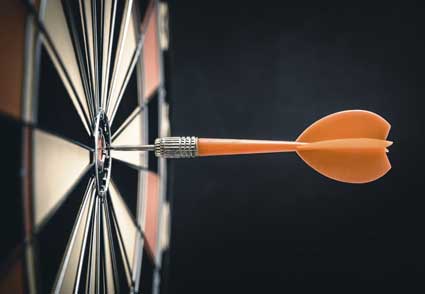A case study is an in-depth study of a singular situation, person or event.
What does this mean?
In most disciplines, studies are required to prove a hypothesis. These studies are usually very large in nature, with the goal of proving a hypothesis. With a case study, a narrow topic is chosen that can prove (or disprove) an idea, question or hypothesis. Often, case studies are used alongside a larger formal study, or are used on their own.
Key Term!
Hypothesis
An idea or theory that hasn't been proven but has scientific merit and is worthy of a study to prove whether it is true or false.
Case studies are used in most disciplines that use or require statistical or informational data. For example, a well-known case study in the field of psychology is the case of "Genie", a feral child.
Obviously, researchers cannot lock up a child for a decade, and do research on the results. So, when a child was discovered locked up for 13 years, it was a perfect opportunity to do research and try to discover what the effects was of a child being isolated it's entire life.
Think!
What information could be garnered from the "Genie" case study? How could the case study be used to help children (or adults) under care today?
Case studies are also commonly used in the business world. For example, one of the most well-known business case studies is the Tylenol cyanide scandal. A quick refresher, in 1982 seven people died after ingesting Tylenol tablets laced with cyanide.
Almost immediately Tylenol's market share dropped from 37% to 7%. Johnson & Johnson, the parent company had to work quickly to save the product. They reintroduced the product with tamper resistant packaging and a large media campaign.
Johnson & Johnson was successful. The Tylenol brand recovered and regained customer trust.
The Tylenol Scandal case study details everything that happened from beginning to end. It also details each step J&J took when turning the scandal around…both positive and negative steps.
This case study is now used in business, marketing, crisis management and other disciplines to help them solve their own problems. They can look at what J&J did to solve their problems, and use that information to fix their own issues.
Who Uses Case Studies?
What makes a case study so valuable is that is it is real-life situation or problem. Dealing with hypothetical issues can be helpful, but using actual historical information and data is often a much better way to learn and fix an organization's problems.
Case studies are used in most disciplines, as well as education, where they are becoming more prevalent. In fact, some of the best universities, such as Harvard Business School, use the case method to educate its students.
Think about it, what better way to learn about a subject than to study real-life examples of similar situations?
Case studies are used in just about every discipline. For this article, case studies will belong to one of the following five groups.
- Arts, Design, Media and Humanities
- Business, Hospitality, Law, Sport and Tourism
- Interdisciplinary
- Education, Social and Environmental Sciences
- Science, Technology, Engineering and Mathematics
Case studies are understandably useful for others to learn from, and an effective case study can help people, businesses, and organizations for years to come. However, what exactly goes into a case study, and how is one developed?
Why Develop A Case Study?
People have several reasons for wanting to develop a case study. For example, a technology company might want to learn why certain members of the population buy certain products. Or a psychologist might want to understand what is the best type of therapy for veterans with PTSD. To accomplish this, both would want to develop a case study.
Let's use our psychologist as an example.
A psychologist wants to begin offering specialized treatment for veterans suffering from PTSD. She currently has many veterans as patients, and she has determined that some therapeutic methods are more effective than others. She wants to use the information she is gaining to develop a track record for which methods are most effective. To do this, she will develop a case study.
The psychologist will use data and information from her current patients (using strict privacy rules), as well as professional resources, to develop her case study. This case study could accomplish many things.
1. Pilot Research – If the psychologist wants to do large-scale research, starting with a few case studies is a great way to go. If the case studies show any patterns or trends, that information can be used to determine the best way to do advanced research.
2. Develop New Theories or Ideas – The psychologist may have her own ideas going into the study. Perhaps she believes that a combination of talk and group therapy is the best treatment for veterans with PTSD. Or maybe through her case study, she realizes that group therapy is often effective alone. If she develops a new theory, she can test it with additional research.
3. Change Existing Theories or Ideas – In psychology, ideas and treatments often change with time or new information or research. While conducting the case study, the psychologist might discover that older ideas are not as effective as newer treatments. If the psychologist feels current professional protocol is not as effective as newer treatments, a case study could be developed to challenge those ideas.
Key Terms!
Intrinsic Case Study
A study on a topic that is unique in itself. An example of this would be the study of Genie, the feral child.
Instrumental Case Study
A study on a more general phenomenon or similarity. An example of this would be a study to determine what therapies are most effective for war veterans with PTSD.
Types Of Case Studies
There are generally five different types of case studies, and the subjects that they address. These are:
Person – This type of study focuses on one particular individual. This case study would use several types of research to determine an outcome.
Group – This type of study focuses on a group of people. This could be a family, a group or friends, or even coworkers.
Location – This type of study focuses on a place, and how and why people use the place.
Organization/Company – This type of study focuses on a business or an organization. This could include the people who work for the company, or an event that occurred at the organization.
Event – This type of study focuses on an event, whether cultural or societal, and how it affects those that are affected by it.
Think!
What kind of case study is the "Genie" study?
What kind of case study is the "Tylenol Scandal" study?
What Is The Process For Developing A Case Study?
While case studies are smaller than larger research-based studies, their development still requires a strict and detailed systematic plan. There are several steps required to complete a full study. The basic plan is as follows:
1. Define The Task, Question or Topic
What is the topic of the case study? What question is the case study supposed to answer?
The first step is to determine what the case study will be about. This is when a researcher will develop their hypothesis.
This is also when research should be done to determine whether any case studies have been written on this topic in the past. This research can be difficult, since many small case studies exist. However, with the advent of the Internet, finding older studies is easier than it was in the past.
2. Do Research, Interviews, Collect Data
The research stage is the longest and most detailed of the case study process.
One of the primary methods used in case studies is an interview. Whether it is one person or several, the interview process is extremely important. Not only must the subject have several interviews, but also other experts in the subject should be interviewed. Their contribution can be invaluable.
When interviewing subjects, questioned should be open-ended so the subject is forced to answer with more than just a "yes" or "no". For example, when interviewing the first responders of "Genie", the researcher shouldn't say:
"When you found Genie, was she afraid of you?"
This question could easily lead to a "yes" or "no" answer. One could easily assume Genie was frightened when found since she had no socialization skills whatsoever. Instead, the researcher should ask questions like:
"When you first found Genie, what was her disposition?"
"When you removed Genie from her home, how did she react to the sunlight and outdoors"?
"When you gave Genie a cookie in the ambulance, how did she react?"
3. Make Recommendations and Form Conclusions
What did the study prove? After gathering all of the data, what conclusions can be made?
Once the researcher has compiled all of the research, it is time to formulate the data and form a thesis. A thesis is a statement that will tell the reader what to expect from the case study. It is a single sentence that usually is within the first paragraph of the report. The thesis must make a claim that can be disputed by others.
The thesis differs from the hypothesis in that the thesis is the statement that is proven true with the case study. The hypothesis is the question or idea that the researcher had going into the study. It is possible the hypothesis and thesis are the same. However, it is also possible that once all the research has been completed, the thesis changes from the initial hypothesis.
4. Write The Report
Writing the report is the final step, but it includes several steps. A case study is a research study that requires a cover page, references, and all of the acquired data and information compiled in a readable and cohesive report.
While a case study might use scientific facts and information, a case study should not read as a scientific research journal or report. It should be easy to read and understand, and should follow the narrative determined in the first step.
Remember, the case study must analyze a case or situation in a clear and concise way, but should also be readable by people not familiar with scientific methods. The study should have four main sections, the introduction, the background of the study and why it was developed, the presentation of findings, and the conclusion.
The introduction should set the stage for the case study, and state the thesis for the report. The intro must clearly articulate what the study's intention is, as well as how you plan on explaining and answering the thesis. Again, remember that a case study is not a formal scientific research report that will only be read by scientists. The case study must be able to be read and understood by the layperson, and should read almost as a story, with a clear narrative.
The background should detail what information brought the researcher to pose his hypothesis. It should clearly explain the subject or subjects, as well as their background information. And lastly, the background must give the reader a full understanding of the issue at hand, and what process will be taken with the study. Photos and videos are always helpful when applicable.
The presentation of findings should clearly explain how the topic was researched, and summarize what the results are. Data should be summarized as simply as possible so that it is understandable by people without a scientific background. The researcher should describe what was learned from the interviews, and how the results answered the questions asked in the introduction.
The final section of the study is the conclusion. The purpose of the study isn't necessarily to solve the problem, only to offer possible solutions. The final summary should be an end to the story. Remember, the case study is about asking and answering questions. The conclusion should answer the question posed by the researcher, but also leave the reader with questions of his own. The researcher wants the reader to think about the questions posed in the study, and be free to come to their own conclusions as well.































